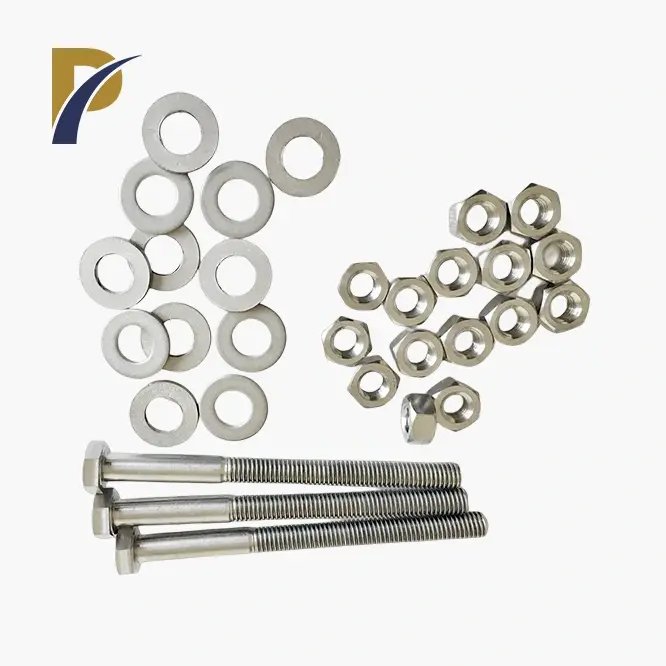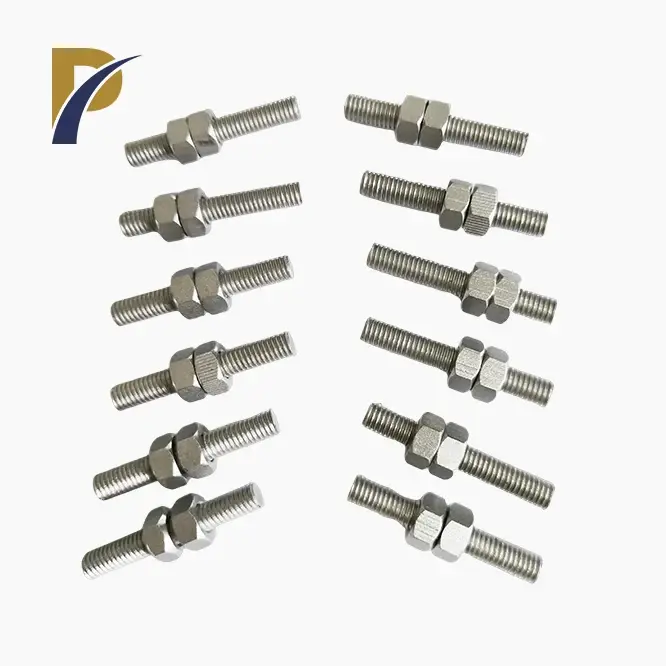Properties and Characteristics of Molybdenum Threaded Rods
Chemical Composition and Purity Levels
Molybdenum threaded rods are crafted from high-purity molybdenum, typically featuring a purity level of 99.95% or higher. This exceptional purity contributes significantly to the rod's corrosion-resistant properties. The chemical composition of these rods primarily consists of molybdenum, with trace amounts of other elements carefully controlled to maintain the desired performance characteristics. The purity of the molybdenum used in these threaded rods plays a crucial role in determining their overall corrosion resistance, as impurities can potentially create weak points or initiate corrosion processes.
Physical Properties and Mechanical Strength
High-purity molybdenum threaded rods boast impressive physical properties that enhance their corrosion resistance. These rods exhibit a high melting point of approximately 2,623°C (4,753°F), allowing them to maintain their structural integrity in extreme temperature environments. The density of molybdenum threaded rods typically ranges from 10.2 to 10.3 g/cm³, providing excellent strength-to-weight ratios. Their exceptional mechanical strength, with a tensile strength often exceeding 700 MPa, enables them to withstand high loads and stresses without compromising their corrosion-resistant properties. The combination of these physical attributes contributes to the overall durability and longevity of molybdenum threaded rods in corrosive applications.
Surface Characteristics and Finish
The surface finish of molybdenum threaded rods plays a vital role in their corrosion resistance. These rods often undergo specialized surface treatments to enhance their already impressive corrosion-resistant properties. Common surface finishes include polishing, electropolishing, or the application of protective coatings. A smooth, uniform surface minimizes potential nucleation sites for corrosion and reduces the likelihood of localized corrosion attacks. Additionally, some high-purity molybdenum threaded rods may feature passivation layers that form naturally or through controlled processes, further bolstering their resistance to corrosive environments. The thread profile and precision of the threading process also contribute to the overall corrosion resistance by ensuring uniform stress distribution and minimizing crevices where corrosive agents could accumulate.
 |
 |
Corrosion Resistance Mechanisms of Molybdenum Threaded Rods
Passivation Layer Formation
One of the key mechanisms contributing to the corrosion resistance of molybdenum threaded rods is the formation of a passivation layer. When exposed to oxygen or other oxidizing environments, the surface of the molybdenum rod reacts to form a thin, stable oxide film. This passivation layer, primarily composed of molybdenum oxides, acts as a protective barrier against further corrosion. The unique properties of this oxide film, including its adhesion to the underlying metal and its ability to self-heal minor damages, significantly enhance the overall corrosion resistance of the threaded rod. The passivation layer effectively isolates the bulk material from direct contact with corrosive agents, thus preserving the integrity of the high-purity molybdenum core.
Electrochemical Stability
Molybdenum threaded rods exhibit remarkable electrochemical stability, which contributes to their corrosion resistance in various environments. The high nobility of molybdenum in the galvanic series makes it less susceptible to electrochemical corrosion when in contact with other metals. This stability is particularly advantageous in applications where the threaded rods may be part of a larger assembly or exposed to electrolytes. The electrochemical characteristics of molybdenum also result in a low corrosion current density, further reducing the rate of material loss due to corrosion processes. This electrochemical resilience allows high-purity molybdenum threaded rods to maintain their structural integrity and performance even in challenging electrochemical environments.
Resistance to Specific Corrosive Media
High-purity molybdenum threaded rods demonstrate exceptional resistance to a wide range of corrosive media. They exhibit remarkable stability in both oxidizing and reducing environments, making them suitable for diverse applications. Molybdenum threaded rods show particular resistance to hot mineral acids, such as sulfuric and hydrochloric acid, as well as many organic acids. Their resistance to chloride-induced stress corrosion cracking is superior to many other metals and alloys. Additionally, these rods maintain their corrosion resistance at elevated temperatures, making them ideal for high-temperature corrosive environments. The ability of molybdenum threaded rods to withstand such a broad spectrum of corrosive media underscores their versatility and reliability in demanding industrial applications.
Applications and Performance in Corrosive Environments
Industrial Applications Requiring High Corrosion Resistance
Molybdenum threaded rods find extensive use in industries where corrosion resistance is paramount. In the chemical processing sector, these rods are employed in reactors, heat exchangers, and piping systems exposed to aggressive chemicals. The aerospace industry utilizes high-purity molybdenum threaded rods in components subjected to extreme temperatures and corrosive exhaust gases. Nuclear power plants benefit from the corrosion resistance of these rods in reactor components and waste processing equipment. The oil and gas industry relies on molybdenum threaded rods for downhole tools and offshore structures exposed to corrosive seawater and hydrogen sulfide. Electronics manufacturing also employs these rods in semiconductor production equipment where ultra-high purity and corrosion resistance are essential.
Performance in Extreme Temperature and Pressure Conditions
The corrosion resistance of molybdenum threaded rods is particularly impressive under extreme temperature and pressure conditions. In high-temperature environments, such as furnaces and combustion chambers, these rods maintain their structural integrity and resist oxidation. The low thermal expansion coefficient of molybdenum ensures dimensional stability, preventing stress-induced corrosion in thermally cyclic applications. Under high-pressure conditions, common in deep-sea exploration or high-pressure chemical reactors, molybdenum threaded rods exhibit excellent resistance to stress corrosion cracking. Their ability to withstand these extreme conditions without compromising their corrosion-resistant properties makes them invaluable in advanced engineering applications where reliability is crucial.
Long-term Durability and Maintenance Considerations
The exceptional corrosion resistance of high-purity molybdenum threaded rods translates to outstanding long-term durability and reduced maintenance requirements. In many applications, these rods significantly outlast alternative materials, leading to extended service life and reduced replacement frequency. The stability of molybdenum in corrosive environments minimizes the need for protective coatings or frequent inspections, reducing overall maintenance costs. However, it's important to note that while highly corrosion-resistant, molybdenum threaded rods may require specific handling and installation procedures to preserve their properties. Proper torque application, avoidance of galvanic coupling with less noble metals, and protection from certain aggressive environments (such as fluorine at high temperatures) can further enhance their longevity and performance in corrosive applications.
Conclusion
Molybdenum threaded rods exhibit remarkable corrosion resistance, making them indispensable in various industrial applications. Their high-purity composition, coupled with unique physical and chemical properties, enables them to withstand aggressive environments, extreme temperatures, and corrosive media. The formation of protective passivation layers, electrochemical stability, and resistance to specific corrosive agents contribute to their exceptional performance. From chemical processing to aerospace engineering, these rods prove their worth in demanding conditions, offering long-term durability and reduced maintenance needs. As industries continue to push the boundaries of material performance, high-purity molybdenum threaded rods stand out as a reliable solution for corrosion-resistant applications.
Contact Us
For more information about our high-quality molybdenum threaded rods and other non-ferrous metal products, please contact us at info@peakrisemetal.com. Our team of experts is ready to assist you in finding the perfect solution for your corrosion-resistant material needs.
